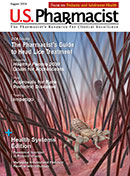Recently, the European Society of Blood and Marrow Transplant (EBMT), in conjunction with the Joint Accreditation Committee of the International Society for Cell and Gene Therapy, released best-practice recommendations for patient care and supply-chain management on the use of CART. CART is used in refractory/relapsed acute lymphoblastic leukemia in pediatric patients and refractory/released diffuse large B-cell lymphoma, high-grade B cell lymphoma, or primary mediastinal large B-cell lymphoma in adults.
The EBMT registry has been established to collect 15 years of follow-up efficacy and safety data. Some patients have experienced cure following CART, whereas about one-half have long-term disease control.
The expert consensus recommendations outline patient eligibility criteria, such as age restrictions, Eastern Cooperative Oncology Group (ECOG) Performance Status (PS) score, history of malignancy, prior allogenic hematopoietic stem cell transplantation, prior anti-CD19/anti-CD3 therapy, bi-specific T-cell engager antibodies, previous CART, history of autoimmune disease, current immunosuppressive treatment, infection risk, and history of central nervous system disorders.
Also discussed are recommended screening laboratory tests and imaging as well as the work-up required prior to performing apheresis and the procedure for performing leukopheresis. The presence of an adequate bone marrow reserve and lack of infection should be documented. Caution is advised in renal impairment, and baseline neurological and pregnancy status should be assessed. Prior to apheresis, ECOG PS score, days post-chemotherapy, days off of corticosteroids, history off hepatitis B or hepatitis C, HIV, syphilis and human T-lymphotropic virus infection, C-reactive protein, and renal, electrolyte, and hematological parameters should be determined.
The recommendations warn that quality-control manufacturing requirements are very limited, and they caution that this limitation should not compromise downstream processing steps. Whether or not leukopheresis can be started prior to salvage, chemotherapy needs to be individualized because it can interfere with the quality of circulating T-cells. Consideration should be given to washout periods prior to leukopheresis following salvage therapy.
Bridging therapy with chemotherapy to maintain disease control during the time between lymphocyte collection and the final administration of the CART product may be needed. Important considerations for bridging therapy are the response to prior chemotherapy or chemo-immunotherapy, the risk of CART-related adverse effects, and the degree of disease burden in relation to the turn-around time for CART. The recommendations also discuss the use of lymphodeleting conditioning prior to CART infusion to improve disease control and cytokine and interleukin functioning.
Procedures should be developed for the procurement, temperature control, and storage of CART.
Factors to consider prior to CART infusion include the presence of active infection, cardiac arrhythmias, hypotension, organ dysfunction, worsening clinical condition, and concomitant medications. Premedication with acetaminophen and an antihistamine can help prevent adverse effects. However, corticosteroids should be avoided since they can damage the CART product.
Short-term complications, those that occur within 14 to 28 days following CART infusion, include potentially life-threatening toxicities such as cytokine release syndrome (CRS), neurotoxicity, and cytopenias. Hospitalization may be needed for the first 14 days. The patient needs to be closely monitored for tumor lysis syndrome (TLS), infections, CRS, and neurotoxicity, which may manifest as CAR-related encephalopathy syndrome, immune effector cell-associated neurotoxicity syndrome, confusion, headache, tremor, hallucinations, abnormal movements, seizures, papilloedema, coma, myoclonus, hallucinations, multifocal hemorrhage, cerebral edema, and death. Prophylactic anticonvulsants are not recommended if the patient does not have a seizure history.
The Immune effector Cell-associated Encephalopathy tool is a screening tool for CART-related CNS adverse effects. C-reactive protein, ferritin, and interleukin-6 can serve as biomarkers for severe neurotoxicity. An algorithm to manage CRS is provided. Prolonged neutropenia is not uncommon following CART and may last more than 30 days. Infection is the second most common adverse event following CNS toxicity. Criteria for anti-infective prophylaxis for bacterial, viral, fungal, and pneumocystis are provided. Bacterial infections are the most common. However, much is not known about the risk for infection in HIV patients or for the reactivation of hepatitis B or C; however, prophylaxis with tenofovir is recommended in hepatitis B.
Medium-term complications are those that occur between Days 28 and 100 following CART and include delayed TLS, delayed hemophagocytic lymphohistiocytosis/macrophage-activated syndrome and CRS, B-cell aplasia, hypogammaglobulinemia, graft versus host disease, and infections.
Long-term complications are those adverse events that occur after 100 days following CART. While there is not much data on this type of complication, it includes prolonged cytopenias and hypogammaglobulinemia.
The future of CART involves preventing the development of resistance to the targeted antigen, incorporating safety “switches” that can help avoid adverse events, automating the production process and developing “off the shelf” allogenic CART products, determining the persistence of beneficial effects, avoiding immune escape, and utilizing nonviral vectors to alter T-cells.
It is important for pharmacists to be familiar with the potential adverse effects of CART and to closely monitor patients, especially since this therapy is relatively new and clinical data are limited. In fact, the EBMT has a pharmacist committee to structure and develop scientific and education activities for pharmacists and clinical pharmacologists involved in the field of stem-cell transplantation and cellular therapy. The FDA has made CART marketing approval contingent on a 15-year postauthorization safety surveillance period. CART is also part of the FDA Risk Evaluation and Mitigation Strategy program.
« Click here to return to Hematology Update.






